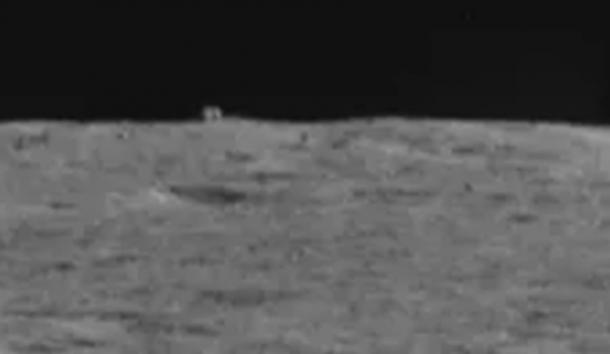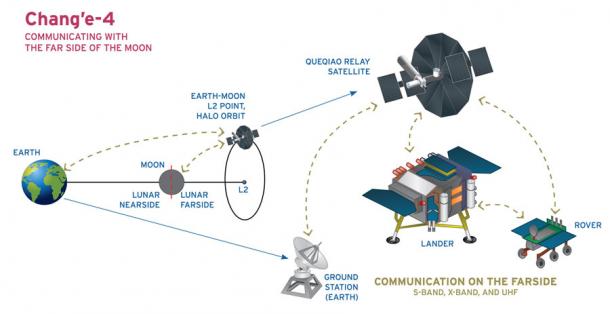A Chinese moon rover exploring the far side of the moon has photographed an anomalous object about 262 feet (80 meters) away from the Yutu-2 moon rover’s camera. This block or cube-shaped structure appears to have rectilinear characteristics, of the type most often seen in buildings intentionally constructed according to architectural designs.
Presumably, this is a naturally-occurring object that only looks like a building. But its surprisingly geometric shape could be consistent with a structure that is man (or alien) made.

The Chinese moon rover spotted this block or cube-shaped “mystery hut” that appears to have rectilinear characteristics on the surface of the moon and the internet is buzzing with the news. ( © CSNA / Our Space )
Is The Moon Rover’s Discovery Artificial or Natural?
Our Space, an online channel affiliated with the Chinese National Space Administration (CNSA), announced the discovery of the strange object in a December 3 press report detailing the Yutu-2 moon rover’s recent performance and discoveries. The solar-powered Yutu-2 moon rover has been exploring the 115-mile-wide (186-km-wide) Von Kármán crater since landing there on January 3, 2019. Since then, it has been moving at a slow and steady pace on its mission to collect new data about conditions on the far side of the moon.
While recently completing a panoramic survey of the moon’s far side horizon, the Yutu-2 spotted the anomalous object perched like a lonely sentinel in an otherwise empty spot on the flattened and mostly featureless landscape of the moon . The CNSA website is referring to this object as a “mystery hut,” in recognition of its artificial looking features.
Intriguingly, the Our Space announcement says the object appeared “out of thin air.” While this may be a way of expressing surprise at its unexpected discovery, this peculiar wording raises the possibility that the rover had photographed the same area earlier and that no object was visible at that time.
At a distance of 80 meters (262 feet), the object in the photograph shows a definite shape. But it is still too blurry to make out clearly.
CNSA mission control personnel have instructed the Yutu-2 to move toward the object, to facilitate an up-close examination. However, the rover must be guided carefully and slowly across the landscape, to ensure its safety. This is why the Yutu-2 has only covered about a half-mile (840 meters) of territory on the floor of the Von Kármán crater so far, despite landing on the moon’s surface nearly three years ago. As a result of its slow but steady pace, it will take the rover between two and three months to reach the anomalous object.
As of now, scientists are assuming the object is a natural rock formation . The current theory is that it is a large boulder that was lifted out of the ground and deposited on the moon’s surface following the crash of a large meteorite nearby.
In February of this year, the Yutu-2 moon rover photographed another mysterious rock or boulder that featured certain regular features, in a different area of the crater. This so-called “milestone” rock was seen jutting up from the moon’s surface, and it had certain characteristics that suggested (at first glance) that it might have been carved to create a pointed shape.
However, a close examination revealed no evidence to suggest the jagged “milestone” rock had actually been shaped by human or alien hands. Scientists believe it is the remains of a once-larger rock formation , most of which has been blasted or peeled away by a series of meteorite impacts. This may have occurred long ago, when the moon was under heavier bombardment than it is today.

How the Chang’e-4 communicates with Earth and the Yutu-2 moon rover on the moon’s far side. (Loren Roberts / CC BY-SA 3.0 )
China Has Big Plans for the Moon, and Beyond
The Yutu-2 moon rover was carried into orbit around the moon on the Chang’e-4 spaceship, before being released to land on the moon’s far side. The first two Chang’e missions carried lunar orbiters that took photographs from space, while the Chang’e-3 mission deposited China’s first moon rover (Yutu-1) on the near side (visible side) of the moon.
In November 2020, the Chinese launched the Chang’e-5 mission. This combination rover/rocket ship was designed to first land on the moon and then later leave and return to Earth, after collecting as many moon rock samples as the vehicle could carry.
The Chang’e-5 has long since completed its round-trip mission. In October of this year, the Chinese Academy of Geological Sciences announced the results of their study of these moon rocks, which determined they were approximately two billion years old.
Notably, this is one billion years younger than the moon rocks recovered by NASA during the Apollo missions of the late 60s and early 70s. Scientists believe these rocks were created by volcanic eruptions, proving the moon was still geologically active at a later date than previous studies had indicated.
As active as this all sounds, it is only the beginning. China has big plans for the moon, and for its rapidly growing space program in general.
The upcoming Chang’e-6 mission will explore the moon’s south pole, searching for frozen water among other possible discoveries. This mission is expected to launch in either 2023 or 2024.
On the already-planned Chang’e-7 and Chang’e-8 missions, rovers will study the moon’s surface and the surrounding space environment in detail, in preparation for a future that will include the construction of a lunar base using 3D printing technology. Once this base is completed, sometime during the next 10-20 years, Chinese astronauts will be able to reside on the moon’s surface for a few days or weeks while carrying out various missions.
The base could be occupied continuously by rotating groups of astronauts, which might include groups from other nations should China decide to share its facilities in the name of science and international cooperation.
In addition to their coming adventures on the moon, the Chinese Space Agency is also finalizing plans to construct their own earth-orbiting space station. Like the International Space Station, which was constructed jointly by the space agencies of the United States, Russia, Europe, Canada, and Japan, this structure would host scientific personnel who would spend months there performing various types of space-based / low-gravity experiments.
The Chinese also have their sights set on Mars. They landed their first rover, called Zhurong, on Mars in 2021, and they plan to return to the Red Planet in the future.
It remains to be seen how NASA and the Russian space agency respond to China’s efforts to establish a beachhead in space. China’s actions may be sparking a new space race , which could be a benefit for humanity if it leads to important technological breakthroughs. Alternatively, it could be a curse if it increases tensions and helps spark a new Cold War between antagonistic nuclear-armed powers.
Of course, it could also lead to a complete re-evaluation of humanity’s place in the universe, should future missions to the moon and to Mars discover anomalous objects that really were built by aliens.
Top image: China’s Yutu-2 moon rover on the surface of the moon as photographed by the Chang’e-4 lander. Source: CSNA / Siyu Zhang / Kevin M. Gill / CC BY 2.0








